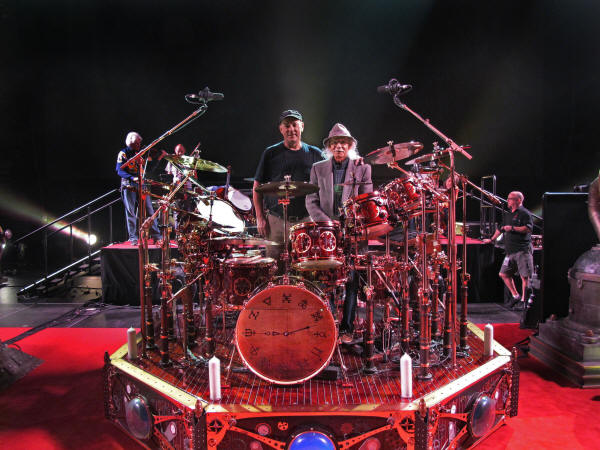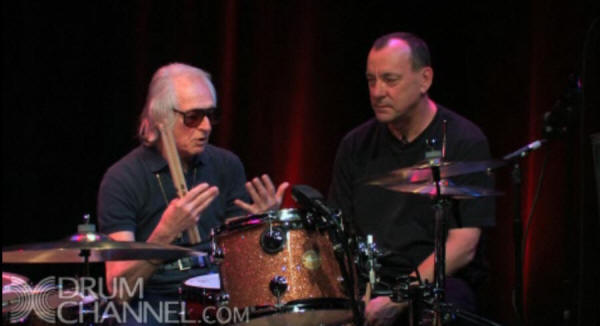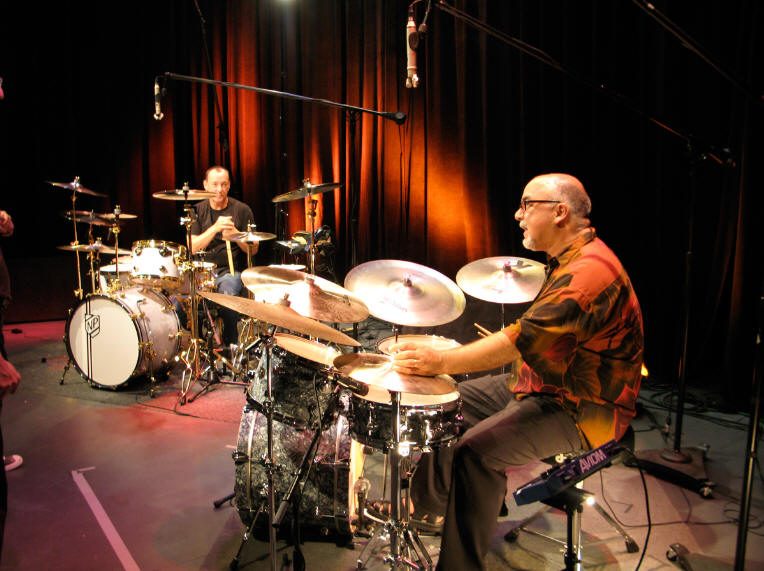Neil Peart's Teachers |
|
Index | Back | Bibliography
In his memoir Traveling Music: The Soundtrack to My Life and Times, Peart wrote the following about his musical and non-musical teachers:
Music and life taught me a lot during those few years, and what a cast of teachers I had. It is said that the man who claims to be self-educated has a fool for a teacher, but I have learned from literally hundreds of people, in music, in reading, and in life, and they became part of a continuum that continues to inspire and drive me onward and upward. At different periods of my development as a drummer, I was directly guided by Don George and Freddie Gruber, but indirectly, my inner sixteen-year-old would forever be inspired by, among countless others, such lifetime exemplars and touchstones as Buddy Rich’s virtuosity and dedication, Hal Blaine’s masterful musicianship, and Keith Moon’s exuberance and abandon. Looking back on my development as a person (in Bill Bruford’s excellent phrase, “life beyond the cymbals”), so many names and faces come surging up. Old friends and neighbors, of course, but more important: so many people who made a positive mark on my life: schoolteachers, drum teachers, life savers, guitar players, grandmothers, and even Mom and Dad. (Traveling Music: The Soundtrack to My Life and Times, pp. 152-154).
Don George (first teacher) - 1965-1966
From Neil Peart's website, "Witness to the Fall."
In 1965, at the age of thirteen, I started drum lessons with Don
at the Peninsula Conservatory of Music in St. Catharines, Ontario.
When he stopped teaching there a year or so later, I didn't see him
again until the day of that first show in Toronto, on October 14,
2012.
In recent years Don and I had been in
touch by mail and email, and he sent me videos of his current
teaching ideas and methods. I was pleased to see that he was
obviously still a gifted and dedicated teacher. For his part, when
talking about this long-ago student, Don was once quoted, "Neil
didn’t have another teacher for thirty years, so I must have done
something right." And he did—Don gave me a strong enough direction toward what I
needed to know that I could follow it through those decades. Most of
all, he gave me the encouragement that I could be a drummer, if I
worked at it. Essentially, Don kept me climbing that mountain for
three decades, until I needed Freddie Gruber and Peter Erskine to
guide me to higher elevations.
Photo by Michael Mosbach, October 14, 2012: Neil Peart and his first drum teacher Don George—from the story "Witness to the Fall"
Freddie Gruber (second teacher) - 1994-1995
By 1994, Neil Peart had accomplished a lot as a drummer. He'd been winning Modern Drummer awards to the point where he was ineligible for some of the categories. To many people, Neil Peart was the world's greatest living drummer. So it might not have made sense when, after facing his limitations during a Buddy Rich Memorial concert in 1991 and producing two Burning for Buddy albums, he began to re-evaluate his drumming technique and feel with teacher Freddie Gruber.
(Freddie Gruber) was a contemporary of Buddy's and played in a big band in the '40s with Charlie Parker. Since then he's taught a lot of guys, like Ian Wallace and Steve Smith. When I heard Steve Smith play I was so knocked out at the progress he'd made in the last few years, I asked him his secret. He said: 'Freddie'. That was enough of a hint for me and I spent a week in New York with Freddie and completely rebuilt my drumming from the ground up. I feel like I've started over as a beginner. To be honest, when I first came into this music (big band jazz), I bluffed my way through it. I sat down and rehearsed every day for months for that concert in 1991 and again before making this record. I spent a lot of time preparing but was not armed with real understanding. I was coming at it with enthusiasm but, as I say, I was bluffing. Now I'm calling my own bluff. Nowadays, when you have to work with sequencers and click tracks there's no room for approximation. I play with the hi-hat firmly rooted, for instance; when you're working with two bass drums in a rock band, you learn not to be a slave to the hi-hat. I've gone back to the basics—now I am a slave to the hi-hat on two and four. It changes the structure of time, which is a real interesting discovery for me." (Rhythm, 1995)
Photo of Freddie Gruber and Neil Peart at Drum Channel
Peart detailed his studies with Gruber in his 1996 instructional drum video A Work in Progress. In the video he talks about Gruber's lessons that led him down a path of rediscovering a new time sense.
Peter Erskine (third teacher) - 2007
In 2007, Neil Peart began studying with Peter Erskine to build on the foundation he'd started with Freddie Gruber. Erskine, one of the great jazz-fusion drummers who played with bands like Weather Report (and also studied with Gruber), helped Peart prepare for another Buddy Rich Memorial concert in October 2008. In his story "The Drums of October," Peart described his studies:
During a break in this summer’s
Snakes
and Arrows tour, I scheduled a lesson with Peter. When I parked in
front of his house in Santa Monica and walked up to the door, sticks
in hand, I had to smile at myself. I was a thirteen-year-old
beginner again, climbing the stairs to the Peninsula Conservatory of
Music on St. Paul Street in St. Catharines, Ontario, for my Saturday
morning lesson with my first teacher, Don George.
And of course, that’s how I had to feel—there’s no point in
taking lessons if you’re not going to surrender to the teacher.
That’s what I had done with Freddie back in ’94—followed his
guidance to the extent of changing just about everything I had done
before, in thirty years of playing: the way I held the sticks, the
way I moved my hands and feet, the way I set up my drums, the way I
sat at them—everything.
When Peter welcomed me into his backyard teaching studio, he told
me he had watched my Anatomy of a Drum Solo DVD, and had
appreciated it.
I said, “Hey, as far as I’m concerned, I’m a butcher, and you’re
a surgeon.”
Peter laughed and spread his hands dismissively, “You’re not a
butcher.”
I raised a hand up high, palm out, and smiled, “Hey—I’m a good
butcher; I’d just like to get a little more surgery into it!”
Later, after he had worked on the exercises that Erskine gave him, Peart was starting to see results.
During the final run of the Snakes and Arrows tour in July, I
started working on Peter’s exercises in my pre-show warmup. When the
tour was (finally!) over, I retreated to my Quebec house, where I
set up a little practice corner in a spare room—just a throne, a
high-hat, and a metronome (a lot more neighbor-friendly than a whole
drumset, especially if you live on a lake in the woods). Every day I
made time (in both senses) to keep working on Peter’s
economy-of-motion ride stroke, and exploring time and rhythm at
different tempos. Then I would put on the headphones and tap along
with one of Peter’s “playalong” selections.
When I got back to California in early September
(2008), I scheduled
another lesson with Peter, and the first thing he asked me to do was
play a quarter-note ride on the high-hat. Peter watched me for a
minute, then nodded and said, “Perfect.”
What a glow of satisfaction
(and surprise!) I felt at that moment. Peter gave me some more exercises to work on, and I continued
practicing every day. By then I had played nothing but high-hat for
over two months (though I must say it never became tedious), and one
day I sent Peter an e-mail, titled “Epiphany."
Today, September 24, 2008, at precisely 4:32 p.m. Pacific Standard
Time, for the first time in recorded history, I commenced to SWING!
It was as if I was looking down from a great height, for I
watched my right hand ticking away on that high-hat, and it was
OWNING THE TIME!
You know what I'm talkin' about!
In his December 2015 article for Drumhead magazine, Peart reflected about Erskine:
The third teacher in my Holy Trinity,
Peter Erskine, modeled a way of looking back on your younger self
with a buddha-like ... amused tolerance. He talked about the
unthinking way he used to set up his drums, or how limited his
playing has been in some technique, with a knowing, comfortable
smile. If he was foolish and lame then, he was better now, and
that's what mattered.
It was Peter who helped me conquer—or at least attack—what was for me the Final Frontier:
improvisation. Having developed a certain amount of compositional
tools and habits over forty years of playing, I was determined to
become freer and more spontaneous. Peter helped me toward that goal
with guidance in developing deeper time-sense and greater
musicality. (With credit to Nick "Booujzhe" Raskulinecz, too, who
encouraged and enabled my improvising in the studio.)
Reflections: New York City, October 2008
It's here that my own path intersects with Peart's—at least as a member of the audience.
In October 2008, I attended the Buddy Rich Memorial Concert in New York City. I had flown across the United States from Seattle because I knew there were few opportunities to see Peart play with a big band. In addition to Peart, some of the greatest drummers in the world graced the stage—with even more sitting in the audience, including Mike Portnoy and Carmine Appice. (Neil's wife, Carrie Nuttall along with Matt Scannell and Peter Collins sat right behind me.)
The excitement built with each performance—Tommy Igoe, John Blackwell, Donnie Marple, Terry Bozzio, Nick Rich (Buddy's grandson), and Chad Smith—leading to the main event. When Peart took to the stage, I could tell something was very different about his playing. Afterward, I was a little ambivalent about how well Peart had played. Something seemed less precise in his playing, at least from what I was used to. A few other fans also commented on this as well.
Later, after I watched his performance on DVD, I finally understood what had happened. What I had perceived as a lack of precision was really a fundamental change in Peart's interpretation of time. With Erskine's guidance, Peart had learned to shift his clock beyond his normal boundaries of precise metronomic time.
Photo: Peart and Peter Erskine at Drum Channel
"Chops and groove"
When Rush returned to the road during the Time Machine and Clockwork Angels tours, I watched Peart continue to refine and develop this new time sense. During the Time Machine tour, I remember a different feel creeping into the Rush songs. This approach eventually led Peart to becoming more improvisational onstage, both in his solo and in songs.
By the time I watched Rush play in Seattle in 2012, on the first leg of the Clockwork Angels tour, Peart had reached at a new level of technique and feel. There was an underlying groove and adventurousness to his playing, but also an incredible amount of power. Peart had finally arrived at what he'd been aiming for with all his studies and practice.
In an email to Erskine, which Peart quoted in his story "Gearing up for the Road" in Issue #10 of Edge Magazine, Peart wrote about his breakthrough:
Also, I had the realization in the past week or so, as the playing started to come together, that these days, "I am playing the way I always wanted to play." Meaning that for all these 47 years I have been working toward this combination of technique, power, and feel — "chops and groove." That's a nice feeling. Shame it took so long!
In an interesting coincidence, Michael Shrieve, the famed
drummer of Santana, interviewed Peart backstage on the same night I
saw Rush in Seattle. One
of the things they talked about was the "invisible click"
that he'd learned from Erskine:
And one thing I learned from Peter Erskine, and I think this is interesting not just to drummers but to musicians, three or four years ago I spent a serious course of study with Peter Erskine, and he had me doing a lot of metronome work and a thing called “the silent count,” where you get two bars of click and two bars of silence. So every day I would set a very slow tempo of that and play just hi-hat. But not just keeping time, you know syncopating and experimenting.… playing. Every single day to a slow tempo and a fast tempo, and it was so impossible at first—and I’ve heard other drummers express this, too. If you have a very, very (speaks slowly) slow, slow, count, and you’re playing along with that click and then … silence… and (snaps fingers, speaks normal speed) to come out of it. Well, six months, day after day, I could after a while. But the unexpected gift that gave me is onstage now if somebody goes out of time by a beat or something, I can hear what is happening and what’s supposed to be happening, because I’d learned to listen to the invisible click.
Index | Back | Bibliography


